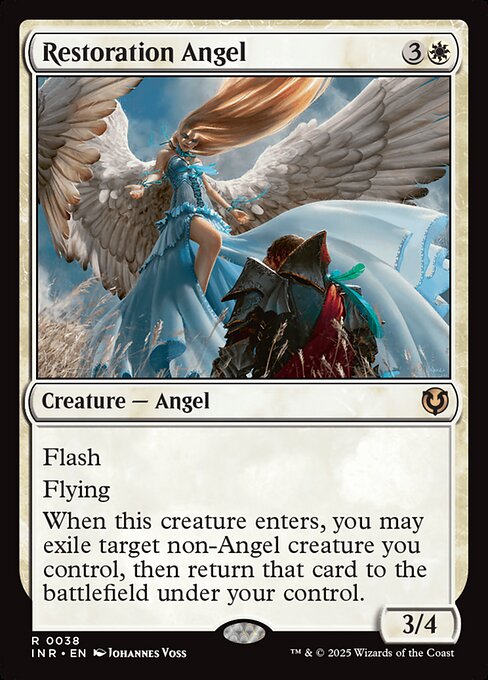
Image courtesy of Scryfall.com
Breaking the Fourth Wall on the Battlefield
In the world of Magic: The Gathering, the fourth wall is less about audience and more about timing, perception, and how players read the story unfolding on the table 🧙♂️. Restoration Angel embodies a quiet, elegant kind of meta-awareness: a white creature with Flash and Flying that arrives with an opportunity to reposition your forces in the blink of an eye. When it enters, you may exile target non-Angel creature you control, then return that card to the battlefield under your control. It’s a design that invites you to question not just what you deploy, but when and how you cycle it back into play. The result is a moment where the game seems to acknowledge your planning, then rewards you for nudging the timeline a beat ahead 🔥💎.
Timing, tempo, and the ETB moment
Restoration Angel costs {3}{W} and carries a sturdy 3/4 profile, which means it’s not merely a tempo drop; it’s a tempo engine. The presence of Flash lets you surprise an opponent by casting it during combat or in response to removal, turning a potential setback into a rebound play. The enter-the-battlefield trigger is where the cleverness lives: you exile a non-Angel creature you control and then return it to the battlefield under your control. That blink-like effect can reawaken a creature’s ETB ability, refresh you on a tough board, or simply reset a fragile threat to avoid a removal spell. It’s a nuanced, almost conversational design choice—the card speaks to the player’s timing and to the opponent’s expectations 🧙♀️⚔️.
Design, at its best, feels like a whispered rule that suddenly becomes a shout. A single line of text can bend the tempo and invite a new rhythm to the game.
Design lessons from a white angel
- Byte-sized complexity with big payoff: A compact ability creates room for rich plays. Choosing which creature to blink and when to do it introduces micro-decisions that compound into larger outcomes.
- ETB synergy without overbearing control: By enabling a re-entry play rather than a one-shot effect, Restoration Angel rewards thoughtful sequencing over brute force, a hallmark of white’s tempo in many formats 🔥.
- Self-referential interactions: The requirement to exile your own non-Angel makes the card a little meta-commentary on how you value your board—it's not about stamping out threats; it's about reimagining them with precision ⚔️.
- Color discipline and value: White’s clarity—combining Flash with Flying and a protective, evasive body—lets you weave resilience into tempo. The result is a card that feels both practical and aspirational, a genuine design touchstone in Innistrad Remastered’s Masters approach 🎨.
Flavor, lore, and the aesthetics of restoration
From Innistrad Remastered, a set that leans into the Gothic-Horror vibe of the original block, Restoration Angel carries a flavor that resonates with the series’ motif of guardianship and second chances. Johannes Voss’s artwork portrays a guardian who arrives with purpose, and the card’s very mechanism—exile and return—reads as a literal restoration of momentum on the battlefield. The rarity is true to Masters-era reprints, underscoring how a seemingly modest effect can become a timeless pivot point in both constructed and EDH circles. In modern contexts, this card remains a go-to for players who relish the elegance of a well-timed blink and the strategic satisfaction of turning a single play into multiple value swings 🧙♂️💎.
Putting Restoration Angel into practice: play tips
If you’re exploring a blink-centric shell, Restoration Angel is a cornerstone that rewards precise timing and resilient board presence. Here are pragmatic guidelines to maximize its impact:
- Pair it with ETB-friendly creatures. The value lies in re-triggering your own sacrifices, saccing, or enters-the-battlefield effects for a favorable loop.
- Use Flash to threaten immediate disruption or to protect a looming threat. The surprise element can force awkward decisions from your opponent and buy you a crucial turn 🧙♂️.
- Combine with recursion and protection packages. Blinking a critical piece and returning it ready to block or attack expands your defensive and offensive options in a single turn, turning a narrow moment into ongoing pressure ⚔️.
- In Commander, the card shines because the table is already primed for multi-step value chains. It’s not just a single, explosive play—it’s a dance of returns and re-entries that can swing the tempo over several turns 🎲.
As we explore the broader themes of breaking conventions in game design, Restoration Angel becomes a quiet mentor: it shows that the most memorable moments often come from strategically deliberate pauses that redefine the next move. And while the battlefield is a fantasy, the real-world delight of spotting a perfectly timed blink is something that resonates with players across formats and communities 🧭🔥.
Clear Silicone Phone Case – Slim, Durable Open Port DesignMore from our network
- https://blog.digital-vault.xyz/blog/post/psychology-of-collectible-rarity-indomitable-ancients-in-mtg/
- https://blog.digital-vault.xyz/blog/post/electrifying-mtg-design-the-future-of-conductive-current/
- https://blog.digital-vault.xyz/blog/post/limited-editions-and-print-scarcity-for-gallia-of-the-endless-dance/
- https://blog.digital-vault.xyz/blog/post/how-to-reduce-server-load-intelligently/
- https://blog.digital-vault.xyz/blog/post/tracking-beautiflys-pokedex-entries-across-generations/